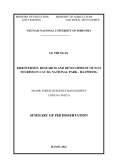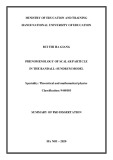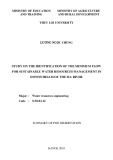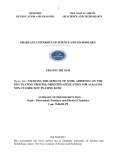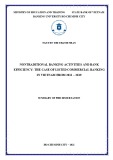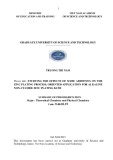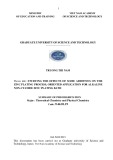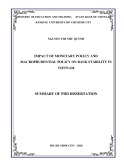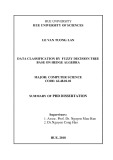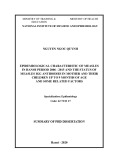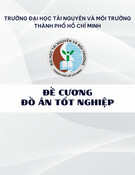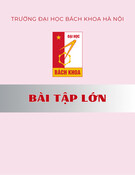MINISTRY OF EDUCATION AND TRAINING
VIETNAM ACADEMY OF SCIENCE AND TECHNOLOGY GRADUATE UNIVERSITY OF SCIENCE AND TECHNOLOGY HOANG VAN CHINH RESEARCHING AND EVALUATING ON THE RESOURCES OF PLANT CONTAING ESSENTIAL OILS AT BEN EN NATIONAL PARK, THANH HOA PROVINCE; PROPOSING THE CONSERVATION MEASURES AND RATIONAL EXPLOITATION SUMMARY OF PHD DISSERTATION
Major: Botany Code: 9.42.01.11
Supervisors: 1. Assoc. Prof. Dr. Tran Minh Hoi
2. Dr. Do Ngoc Dai
HANOI – 2019
This dissertation has been carried out at The Graduate University of
Science and Technology - Vietnam Academy of Science and Technology
Supervisors: Assoc. Prof. Dr. Tran Minh Hoi
Dr. Do Ngoc Dai
The 1st Reviewer:
The 2nd Reviewer:
The 3rd Reviewer:
The dissertation will be defended at the Board of Examiners of Graduate
University of Science and Technology, Vietnam Academy of Science and
Technology at …. on ...
The thesis can be found at the National Library of Vietnam and
Library of Graduate University of Science and Technology
INTRODUCTION
1. The urgency of the thesis topic
Vietnam is located in the monsoon tropical areas, with a great range of terrains, soil types, landscapes, and different climate characteristics among regions, leading to favorable basis for biodiversity of species composition and species richness. Vietnam is ranked 16th in the world in terms of diversity of biological resources. In the "General Flora of Indochina" and subsequent additional episodes, about 240 families with more than 7,000 vascular plants were described and recorded. In recent years, that number is predicted could reach 15,000 species by many botanists. Currently, about 13,000 species of vascular plants have been recorded, of which about 660 essential oil plants species (accounting for about 6.3% of the total number of known species) are. The known essential oil plants belong to 357 genera (accounting for about 15.8% of total genera) and 114 families of vascular plants (accounting for 37.8% of the total) in the flora of Vietnam. The families which have plenty of genera and species containing essential oils are: Asteraceae, Zingiberaceae, Rutaceae, Lamiaceae, Lauraceae, Apiaceae, Myrtaceae ....
The more developed societies are, the higher in the demand for learning and using natural origin compounds. The essential oil plants play an important role in the groups of resourcing plants. Those are essential materials for cosmetic, food and pharmaceutical industries.
Ben En National Park is located in northwestern Nhu Thanh district, about 46 km southwest of Thanh Hoa city, with geographical coordinating from 19º28 'to 19º39' north latitude; 105º20' to 105º35' East longitude. The natural area of the park is 16,634 ha, including 16 sub-zones, Song Muc lake and Da Van mountain area, Song Chang.
1
Ben En National Park consists of mixing types of hills, mountains, rivers and lakes. The center of National Park is Song Muc lake with a system of floating islands covering by forests and many spreading branches surrounded by mixing mountains and land rocky terrain. The highest mountain is Dam, with 497 m height. The other mountains are 300-350 m, with average slope from 250 – 300 m, even above 350 m. This terrain is quite rugged, with steep slopes, with many limestone mountains containing caves and forests inside. At Ben En National Park, there are plenty of precious essential oils species such as Cinnamomum parthenoxylon Meisn., C. balansae H. Lecomte, C. loureirii (L.) Presl, Citronella spp., Ardisia silvestris Pitard, Artemisia annua L., Plectranthus aromaticum Benth....
Currently, there are a number of studies on flora in Ben En National Park, such as studies of Do Ngoc Dai et al (2007), Hoang Van Sam (2008), Ben En National Park (2013). Regarding essential oil plants, there are only a few studies on chemical compositions and antibacterial activities in some species of several authors such as Do Ngoc Dai, Nguyen Anh Dung, Ngo Xuan Luong ... However, those authors only concerned about some aspects, and did not focus on essential oil plant resources. Due to those reasons, the research topic "Researching and evaluating on the resources of plant containing essential oil at Ben En National Park, Thanh Hoa province, proposing the conservation measures and rational exploitation" was choosen, with both scientific and practical significances. 2. Researching objectives
- Evaluating the diversity and using values of essential oil plants at
Ben En National Park, Thanh Hoa province.
- Determining the content and composition of essential oils of some
plant species.
- Determinating the anti-mosquito and anti-microbial activities of
essential oils of Zingiber zerumbet (L.) Smith
- Proposing the conservation measures and rational exploitation to
essential oil species at Ben En National Park, Thanh Hoa province. 3. Scientific and practical significances of the study
- Scientific significances + Establishing new and relatively completed data on the variety of
essential oil plants at Ben En National Park, Thanh Hoa province.
+ Providing new data on the content and chemical composition of essential oils in the leaves, stems, roots, shells and fruits of 33 samples of 19 species. For the first time, data on essential oils of 6 species were provided.
+ Providing new data on anti-mosquito and anti-microbial activities of
essential oils in rhizome of Zingiber zerumbet (L.) Smith.
- Practical significances + Contributing information for admistrators in developing strategies to conserve essential plant species at Ben En National Park based on the scientific results, as well as proper preserving and exploiting suggestions.
2
+ Providing a list of valuable essential oil species which will support the orientation of reasonable management, exploitation and sustainable development in the future.
4. Structure of the dissertation
The dissertation consists of 168 pages, except for Introduction, Conclusions and recommendations, References, and Appendix parts, the dissertation includes three main chapters:
Chapter 1. Literature review: 30 pages Chapter 2. Subjects, contents and study methods: 7 pages Chapter 3. Results and Discussions: 102 pages
CHAPTER 1 LITERATURE REVIEW
1.1. General information of essential oils 1.1.1. Essential oil plant definition
The essential oil plants are plants containing specialized structures that
are responsible for secreting and accumulating essential oils. 1.1.2. Characteristics and chemical compositions of essential oils
Essential oils are mixtures of organic compounds, have complex molecular structures, are insoluble in water, volatile and have a characteristic aroma. 1.1.3. Natural state and distribution of essential oils
- Essential oils are in latent or free state in plant body, it could present
in all parts or concentrated in only one or several parts of plant.
- In general, essential oil plants present in the entire plant kingdom but
they especially present in some families. 1.1.4. Using values, importance of essential oils and materials containing essential oils
For a long time, people have used essential oils in daily life as well as the pharmaceutical, food processing, cosmetic industries... Many plant species containing essential oils have become popular crops. 1.2. Study on essential oil plants in the world and in Vietnam 1.2.1. Study on essential oil plants in the world
Up to now, there have not been enough documents to visualize the history of the world of essential oil study. The earliest document about essential oil plants is the "Medicinal Plants" book found in Japan, written in 890. In this book, nearly 100 essential oil species were documented, and processing and using these plants were described as well.
3
It is shown that scientists pay special attentions on essential oils and essential oil plants from the early twentieth century; Oustanding studies were published by Charabot and his colleagues in 1903, 1904, 1907. In later
times, this kind of studies increased rapidly and belong to many research aspects.
from biological ecological and
According to Brian M. Lawrence, in the project "Progress in essential oils" (1992-1994) and "Essential oils" (1995-2005), the author documented about 1.000 essential oil plant species which were analyzed for chemical compositions on the world. According to L.P.A. Oyen and Nguyen Xuan Dung (1999), in the "Essential oil plants in South-East Asia", in Southeast Asian countries, there are more than 70 essential oil plant species analyzed for chemical compositions, of which about 30 species were studied characteristics, comprehensively distribution, cultivation, development, using values, yield and trade and chemical compositions. 1.2.2. Study on essential oil plant species in Vietnam
The studies on essential oil plants in Vietnam began after 1956. During that time, a series of studies on Mentha piperita L., Citronella spp., Litsea cubeba, ... were reported. According to La Dinh Moi and Luu Dam Cu (2001), about 20 essential oil plant species were recently natural exploited and planted in more or less 600 known species (only 3% of total known essential oil plant species). Those species are popular cultivated species such as Citronella spp., Mentha piperita, Ocimum tenuiflorum, Cinnamomum camphora, Melaleuca sp., C. loureirii (L.) Presl, Pogostemon cablin (Blanco) Blanco... 1.2.3. Study on essential oil plant species in Thanh Hoa and at Ben En National Park
Essential oil plant studies were only scattered in some species, and were
not systematic in this area. 1.3. Study on chemical composition and biological activity of some plant families in the world and in Vietnam 1.3.1. Study on chemical composition and biological activity of some plant families in the world 1.3.1.1. Lauraceae
4
In the world, studies on essential oil of Lauraceae mainly focused on the perfume, pharmaceutical, cosmetic and antifungal, antibacterial pratical applications. The studied species often belong to the genera Cinnamomum, Litsea, Machilus ... 1.3.1.2. Rutaceae Most of the species in the Rutaceae have essential oils or aromas, and there are many studies in the world on essential oils of Rutaceae. The author has summaried main studies until 2018.
Studies on Zingiberaceae in the world, mainly focused on the genus
1.3.1.3. Piperaceae Currently, there are many studies in the world on the chemical compositions of essential oils and biological activities of the species in Piperaceae. Those studies focused mainly on the genus Piper. 1.3.1.4. Zingiberaceae Curcuma, Zingiber, Alpinia, Amomum ... 1.3.2. Study on chemical composition of and biological activity of some plant families Vietnam 1.3.2.1. Lauraceae
There are 21 genera, 273 species belonging to Lauraceae in Vietnam The studies on essential oils are mainly focused on Cinnamomum, Litsea, Machilus, Phoebe ... 1.3.2.2. Rutaceae
There are more than 15 essential oil plant species of Rutaceae in Vietnam. Studies on essential oil plant species of Rutaceae maily focused on some genera such as Citrus, Clausena, Zanthoxylum, Euodia, Glycosmis... 1.3.2.3. Piperaceae
In Vietnam, studies on essential oil plant species of Piperaceae began
3 decades ago and mainly focused on the genus Piper. 1.3.2.4. Zingiberaceae
In Vietnam, there are about 21 genera with more than 140 species in Zingiberaceae; although it is not huge family, but most of its species have essential oils. Until now, there are more than 40 essential oil species studied. 1.4. Natural, economic and social conditions of the study area 1.4.1. Geographical location
Ben En National Park is located in northwestern Nhu Thanh district, with geographical coordinating from 19º28' to 19º39' 'North latitude, from 105º20' to 105º35' East longitude. 1.4.2. Geology and soil
The main types of soil of Ben En National Park are: Alluvial soil and streams, yellow red feralit soil, developed on the group of clay, pale yellow feralit soil developed on sand and weathered groups on limestone mountains. 1.4.3. Topographic
This area has different types of hills, mountains, rivers and lakes with
5
quite rugged terrain. 1.4.4. River
There are two main river systems in this ares namely Muc river and Chang river and Ben En lake with a water capacity of 250 - 400 million m3. 1.4.5. Climate
Ben En has a subtropical climate: cold and dry winter; hot and humid
summer. 1.4.6. Status of forest land at Ben En National Park
The area of forested land in Ben En National Park is 11,738.07 ha,
accounting for 79.66 %. 1.4.7. Social conditions
At Ben En National Park area, there are 1 town, 16 communes, 7 state- owned units; Total population is 41,672 citizens, with complex ethnic composition.
CHAPTER 2 SUBJECTS, CONTENTS AND METHODS
2.1. Study subjects
Essential oil plant species distributing in Ben En National Park, Thanh
Hoa province. 2.2. Study timing The project was conducted from March 2014 to September 2018. 2.3. Study contents
- Making a list of essential oil plant species and evaluating the
diversity of essential oil species.
- Investigating on the using values of essential oil plant species. - Determining the content and chemical compositions of some
essential oil plant species.
- Testing the activity against Aedes albopictus adult mosquitoes, Culex quinquefasciatus mosquito larvae and anti-microbial activities of Zingiber zerumbet.
- Proposing the conservation measures and rational exploitation.
2.4. Study methods 2.4.1. Method of inheriting documents
Inheriting the research results on natural and social conditions in the study area, plant samples stored in domestic and foreign museums, published studies relating to the PhD topic. 2.4.2. Field investigation method
6
Based on the map, the main survey lines were selected, including 6 main routes, namely Song Chang; Xuan Thai-Yen Bai; lake road (Plant Island and other islands); Binh Luong; Xuan Hoa - Xuan Quy and Hai Van - Tan Binh.
2.4.3. Methods of sampling and classification
- Each sample must have all the parts, especially: branches, leaves, flowers and even fruit as well (for large trees) or even whole plant body for herbaceous plants.
- From 3-5 samples per each species, and for herbaceous plants, similar samples were collected with the same number above to study and discuss about the deformations of the species.
- Samples collected on the same individual together a common label. - All samples were taken photos by Canon digital camera. Samples were pretreated in the field, and afterwards, they were dried
in the Herbarium at Hong Duc University.
Samples collected during the field trips were brought back to the
laboratory for further analysis and processing.
Squeezing: Before pressing on the dried, flat and thick newspaper, all the leaves are fully stretched, not curled edges, parts of flowers or fruits are opened or cut out to facilitate analysis, pressing and drying samples. Sample drying: Samples after pressing are dried immediately. Specimens were identified by comparative morphological method. For difficult specimens, expert method was used. A total of more than 1,000 samples were collected and used for analysis and scientific identification. The sample is currently stored at the Herbarium, Faculty of Natural Sciences, Hong Duc University. The main documents used in scientific identification are: - Vietnamese herbs (Pham Hoang Ho, 1999 - 2003); - Handbook to Reference and identification of the families of
Angiospermae Plants in Vietnam (Nguyen Tien Ban, 1997);
- General flora of Indochina (1907); - Flora of China (1994-2002); - Set of Vietnamese botanicals
(Annonaceae, Verbenaceae, Myrsinaceae, Lamiaceae, Lauraceae, Zingiberaceae) and some other specialized materials.
Adjusting the scientific name and developing the list: Adjusting the scientific name according to the List of Vietnamese plant species and The plant list website (http://www.theplantlist.org); Sort the list by R. K. Brummitt and colleagues (1992). 2.4.4. Methods to assess the diversity of flora
- Diversity of taxa of flora: According to Nguyen Nghia Thin's method
7
(1997).
+ Evaluating the diversity of taxa in division (reporting the number of species, genera and families according to each division from low to high based on the list of flora, calculating the percentage of each taxon to avaluate their diversity level).
+ Assessing the species diversity of each family (identifying the species richness of family, calculating the percentage (%) of species of those families compared to the whole of the flora).
+ Evaluating species diversity of genera (identifying species richness of genera, calculating the percentage (%) of species of those genera to the whole species of the whole flora).
- Diversity in stem forms: Based on the record of the field survey, án related documents and divided according to "Vietnam Forest Plants" for reporting and assessing stem forms of essential oil plants.
- Diversity of using values of flora: Reporting using valuable species from the list of plants with specialized documents, such as: Vietnamese medicinal plant dictionary (2012), 1900 useful plant species in Vietnam (1993), Checklist of plants species of Vietnam (2003, 2005),"Vietnamese plants (1999-2003), Medicinal plants and medicinal herbs in Vietnam (2003), Medicinal plants and medicinal animals in Vietnam, ...
- Diversification of rare and precious plant species and conservation issues: Based on Vietnam Red Data Book (2007) and IUCN red list, reporting rare species and conservation status. 2.4.5. Methods of identifying the chemical compositions of essential oils 2.4.5.1. Sample collection and essential oil distillation
Samples for essential oil distillation included separate parts of the plant (leaves, branches, shells, pneumatophores, rhizomes, flowers, fruits). 0.5-3 kg fresh sample was collected. Samples were labeled with identified number (similar to species identified number) and the collected time. After collecting, samples were chopped and distilled by the method of attracting refluxed water in Clevenger equipment in 2 - 4 hours at standard pressure according to Vietnam Pharmacopoeia (2009).
2.4.5.2. Quantitative method of essential oils
Essential oils of different parts were quantified according to the First method of Vietnam Pharmacopoeia (2009). The content of fresh essential oils (X (%)) were calculated according to the formula:
𝑋 (%) = × 100
8
(when d < 1) 𝑎 × 0.9 𝑏
Or according to this formula
𝑋 (%) = × 100 𝑎 𝑏 (when d > 1)
Where:
a is the volume of the essential oil in ml b is the mass of the sample in grams.
The essential oils were dried with anhydrous Na2SO4, stored in sealed standard vials at 0 - 5º C before further analysis. 2.4.5.3. Methods of chemical composition analysis of essential oils
Preparation of analytical samples for gas chromatography: Dissolving 1.5 mg of dried essential oil by anhydrous Na2SO4 in 1 ml of pure hexane for chromatographic analysis.
+ Gas chromatography (GC) with FID detector: Made on Agilent Technologies HP 6890N Plus with FID detector, capillary column HP-5MS length of 30 m, internal diameter (ID) = 0.25 mm, layer film 0.25mm thin with carrier gas is hydrogen. The temperature of the sample pump chamber is 250º C. Detect temperature is 260º C. Program temperature 60º C (2 minutes), increase 4º C/minute to 220º C, stop at this temperature for 10 minutes.
+ Gas chromatography mass spectrometry (GC/MS): It is carried out on Agilent Technologies HP 6890N/HP 5973 MSD conjugated gas chromatography system with separation column and chromatographic operating conditions as mentioned above and with helium as carrier gas. The qualitative determination of essential oil components was done by the following methods:
- Based on the values of the Retention Index, determinng with a
sequence of n-alkanes in the same chromatographic condition.
- Based on mass spectra, comparing with mass spectra found in data
banks (NIST 08 and Wiley 9th Version) or comparing with the references. The percentage of components in essential oils were calculated based on the area or height of the chromatographic peak (detector FID) without using any adjustment factors. 2.4.6. Methods of investigation and interview
9
To assess the current status of management, exploitation and use of plant resources containing essential oils, conducting surveys and direct interviews with the managers and people. 2.4.7. Biological activity test methods
Test of mosquito resistance: Mosquito resistance activity was
determined by Reed-Muench method [164].
Adult mosquitoes: Aedes albopictus and Culex quinquefasciatus were maintained in insect cages (40 x 40 x 40 cm) and fed by 10% of sugar solution and rat blood. Hatching eggs were spread out by tap water. Aedes albopictus larvae were kept on plastic trays (24 × 35 × 5 cm). Their larvae were fed by dog biscuits and yeast flour at a ratio of 3: 1. All steps were held at 25 ± 2°C, 65 - 75% relative humidity, and a dark cycle of 12 : 12 at the Research Center for entomology and parasites, Duy Tan University.
The anti-mosquito activity of rhizomes essential oils of Zingiber zerumbet was evaluated according to WHO protocol (2005) with minor changes. For the assay, the essential oil fraction was dissolved in EtOH (1% stock solution) was placed in a 200 ml beaker and was added water containing 20 larvae (fourth instar). For each test, a controller using EtOH was also run for comparison. Mortality rates were recorded after 24 hours and after 48 hours of exposure while not supplemented with nutrients. The experiments were carried out at 25 ± 2° C. Each test was replicated four times in every concentrations (70, 60, 50, 40, 30 and 25 μg/mL). The average lethal concentration (LC50) was determined by the Reed-Muench method.
Testing the resistance to test microorganisms Testing the biological activities of essential oils on some Gram (+) strains: Bacillus subtilis (ATCC 6633), Staphylococcus aureus (ATCC 13709); Gram (-) bacteria: Escherichia coli (ATCC 25922), Pseudomonas aeruginosa (ATCC 15442); Mold: Aspergillus niger, Fusarium oxysporum and yeast: Saccharomyces cerevisiae, Candida albicans.
1st step. Qualitative test by diffusion method on agar plate, using filter
paper to impregnate the test substance with standard concentration.
The strains of inspection microorganisms include: - Bacteria Gr (-): E. coli, P. aeruginosa. - Bacteria Gr (+): B. subtillis, S. aureus. - Mold: A. niger, F. oxysporum - Yeast: S. cerevisiae, C. albicans.
2nd step. Samples with positive activities in 1st step were tested continuously in 2nd step to calculate the minimum inhibitory concentration (MIC) according to the method of Vanden Bergher and Vlietlink (1991) conducted on microtitre plates in 96 hours.
10
Types of antibiotics tested were: Ampicilin, Tetracycline, Nystatin
Samples, with a value of MIC ≤ 50 πg /ml, were considered to be
antimicrobial positive. 2.4.8. Data analysis
Data were analyzed on Microsoft Office Excel 2007 software.
CHAPTER 3: RESULTS AND DISCUSSIONS 3.1. Diversity of essential oil plant resources at Ben En National Park, Thanh Hoa province 3.1.1. Division diversity
The results showed that there were essential oil 410 species, belonging to 180 genera and 42 families of 2 divisions namely Magnoliophyta and Pinophyta (Table 3.1) at Ben En National Park. Further more, one additional species was recorded for the flora of Vietnam, Ben En Pepper (Piper minutistigmum C. DC.). Table 3.1. The distribution of essential oil plants in division of flora of Ben En National Park
Family Genus Species
Division
Number of family 2 43 37 6 Ratio (%) 4,44 95,56 82,22 13,33 Number of genera 2 178 166 12 Ratio (%) 1,11 98,89 92,22 6,67 Number of species 2 408 369 39 Ratio (%) 0,49 99,51 90,00 9,51
6,17 13,83 9,46
Pinophyta Magnoliophyta Magnoliopsida Liliopsida Mag./Li Ratio Sum 45 410 100 100 180
taxa concentrated The results showed in
100 the that most of Magnoliophyta with 408 species, accounting for 99.51 % of total species; 178 genera, accounting for 98.89 % and 43 families, accounting for 95.56 % of the total of them; there were only 2 species in Pinophyta, accounting for 0.49 %; 2 genera, accounting for 1.11 % and 2 families, accounting for 4.44 %. Thus, taxa with essential oils mainly concentrated in Magnoliophyta with the number of genera and species accounting for over 95%. This is perfectly reasonable compared to the evolution of plants because the Magnoliophyta is the dominant of higher vacular plants.
The uneven distribution of taxa was not only shown between divisions
but also among classes in the Magnoliophyta.
11
The Magnoliopsida had a number of taxa that dominate over 80 % of the total number of families, genera and species of division; Liliopsida had 6 families (accounting for 13.33 %); 12 genera (accounting for 6.67 %) and
39 species (accounting for 9.51 %). This is reasonable, because Magnoliopsida always dominates over Liliopsida and is consistent with studies of La Dinh Moi et al (2001), Nguyen Nghia Thin (2008) in studied on other flora areas in Vietnam.
Comparing with the list of flora of Ben En National Park, Thanh Hoa province, which were recorded 59 essential oil species, it was found that there were only 36 species having essential oils and 23 species having fatty oils (List of flora of Ben En National Park, 2013). In short, our results identified and supplemented 374 species to the list of essential oil species at Ben En National Park, bringing the total number of essential oil species to 410 species. In addition, for every 6.1 families of Magnoliopsida, there was 1 family of Liliopsida; 13.83 genera of Magnoliopsida versus 1 genus of Liliopsida and 9.46 species of Magnoliopsida versus 1 species of Liliopsida. 3.1.2. Family diversity
Of the total 45 families having essential oils at Ben En National Park, there were 10 richness families (from 16 to 56 species), accounting for 22.22 % of the total families, 298 species, accounting for 72.68 % of the total species. Typical families are Lauraceae - 56 species, Annonaceae - 46 species, Asteraceae - 35 species, Rutaceae - 33 species, Zingiberaceae - 32 species, Verbenaceae - 24 species and the species having the least species were Lamiaceae and the Scrophulariaceae with 16 species. 3.1.3. Genus diversity
With 10 most diverse genera out of 180 genera of essential oil species (from 7 20 species), accounting for 5.56% of total genera, there are 112 species, accounting for 27.32 % of total species, including Piper - 20 species, Litsea - 17 species, Cinnamomum and Alpinia with 12 species, Syzygium - 10 species, Lindernia and Polyalthia with 9 species; Jasminum and Zingiber with 8 species, and Phoebe with 7 species. 3.1.4. Comparing composition of essential oil species at Ben En National Park with the ones at Pu Mat National Park and in Vietnam
* Comparing with Pu Mat National Park In order to reveal the diversity of essential oil species at Ben En National Park, the results were compared with essential oil species at Pu Mat National Park by Nguyen Viet Hung (2017) (Table 3.4). Table 3.4. Comparison of essential oil plants in Pu Mat National Park compared to Vietnam's essential oil plants
Ben En Pu Mat(1)
12
Division Ben En/Pu Mat ratio (%) Number of species Ratio (%) Number of species Ratio (%)
2 408 0,49 99,51 6 355 1,66 98,34
16.000 94.000
1Nguyễn Viết Hùng (2017).
Pinophyta Magnoliophyta Area (ha) Sum 410 100 361 100 33,33 114,93 17,02 113,57
The results in table 3.4 shows that the number of essential oil plant species belonging to Pinophyta at Ben En only accounted for 33.33% compared to Pu Mat ones; however, the total number of species in the Magnoliophyta at Ben En was higher than that of Pu Mat (equal to 114.93 %). Meanwhile, the area of Ben En only accounted for 17.02% compared to Pu Mat and the vegetation in Ben En only distributed in the low belt (from 500 m or less) and in Pu Mat, there were both high and low belts (as high as 1,800 m). Thus, the the number of essential oil plant species at Ben En was higher than that of Pu Mat although the area of Pu Mat was more than 6 times higher and the number of species of plants has 1.6 times higher. Those differences may be due to the differences in investigation and evaluation. * Compare with Vietnam
Results on essential oil species at Ben En National Park compared with
Vietnam showed in Table 3.5. Table 3.5. Comparison of essential oil plants of Ben En National Park versus essential oil plants of Vietnam
Ben En Vietnam(2)
Division
Number of species 2 408
Ratio (%) 0,49 99,51
Number of species 21 636
Ratio (%) 3,20 96,80
16 330.000
(2)Luu Đam Cu (2000).
Pinophyta Magnoliophyta Area (km2) Sum 410 100 657 100 Ben En/Vietnam ratio 9,52 64,15 0,0048 62,41
The data in Table 3.5 show that the number of essential oil species in Ben En National Park accounted for 54.95 % of the total number of known and recorded essential oil plants in Vietnam. Moreover, there were differences in the distribution of essential oils in Pinophyta and Magnoliophyta at Ben En National Park vs. Vietnam. These differences may be due to the fact that Ben En National Park is characterized by a low mountainous area, surrounded by people, with a long-term impact on forest vegetation. In addition, essential oil species in Pinophyta mainly distributed in high belts, therefore there were only 2 species that made up 0.49 % of the 13
total plant species. Moreover, Ben En National Park, locating in the tropical monsoon climate, is very convenient for the species of Magnoliophyta to grow and develop. 3.1.5. Diversity in stem forms
Studies on the stem forms of essential oil species in Ben En National Park, based on "Names of Vietnam forest plants" revealed 5 main stem forms namely big large woody tree, small woody tree, bush tree, climbing plant and herbaceous plant (Table 3.6). Table 3.6. Body forms of essential oil plants at Ben En National Park
TT Dạng thân ID Ratio (%)
Number of species 83 1 GOL 20,24
Large woody tree (over 16 m high) Small woody tree (6-16 m) GON BUI The bush tree GLT Climbing plant TH
2 3 4 5 Herbaceous plant Sum 98 65 41 123 410 23,90 15,85 10,00 30,00 100
In which, 65 species were shrubs, accounting for 15.85 % and mainly belonging to Verbenaceae, Euphorbiaceae, Araliaceae, Annonaceae, ...; 83 species were large timber plants, accounting for 20.24% of the following families: Podocarpaceae, Magnoliaceae, Lauraceae, Euphorbiaceae, Myrtaceae, ...; 98 species were small timber plants, accounting for 23.90 % with main families such as Annonaceae, Araliaceae, Lauraceae, Myrtaceae, Magnoliaceae, ...; 41 species were climbing plants, accounting for 10.00 % concentrated in Piperaceae, Annonaceae, Rutaceae, ...; Herbaceous plants included 123 species, accounting for 30.00 %. Therefore, herbaceous plants were the most diverse, belonging to Zingiberaceae, Asteraceae, Araceae, Lamiaceae... 3.1.6. Diversity in using values In addition to the essential oils using value, these plant species were listed for other using values such as medicine, edible, spice, wood, ... Report of using values based on documents: Dictionary of medicinal plants, 1,900 useful plant species, Checlist of Vietnamese plant species, .... The other using values of essential oil plants were presented in Table 3.7.
Table 3.7. Other using values of essential oil plants at Ben En National
Park
14
ID
TT Using values 1 Medicinal plants 2 Wood plants 3 Ornamental plants 4 Edible plants 5 Essential oil plants 6 Herbs 7 Fatty oil plants THU LGO CAN ĂNĐ CTD CGV CDB Amount 286 101 24 69 410 13 5 Ratio (%) 69,76 24,63 5,85 16,83 100 3,17 1,22
- Essential oil plants: These are plants containing essential oils, and they have been studied extensively, such as the studies of La Dinh Moi et al (2001), Tran Dinh Thang et al (2014), ... In addition, during the study, the chemical compositions of essential oils were distilled and analyzed such as Piper leptostachyum, Michelia alba, Atalantia roburxghiana, Tetradium trichotonum, Macclurodendron oligophlebia), Cinnamomum glaucescens, Cinnamomum verum, and Amomum muricarpum, ...
Some genera with large amount of stored essential oils widely distributed at Ben En National Park such as Amomum, Alpinia, Homalomena, Zanthoxylum, Clausena, Euodia, ...
- Medicinal plants consisted of 286 species. In addition to the value of essential oils, those species were also medical used by the people in the study areas, mainly improving health, weather and bone pain killer...
to - Ornamental plants consisted of 24 species, belonging Podocarpaceae, Annonaceae, Asteraceae, Magnoliaceae, Myrtaceae, ... some species were used as typical ornamental plants such as Artabotrys hongkognensis Hance, Desmos chinensis Lour., Desmos cochinchinensis Lour., ...
- Edible plants included 69 species, were also used by people as daily vegetables or fruit, ... Some typical species such as Schefflera heptaphylla (L.) Harms, Zanthoxylum acanthopodium DC., Zanthoxylum myriacanthum Wall. ex Hook.f., ...
- Wood plants consisted 101 species, mainly belonging to
Magnoliaceae, Lauraceae, Myrtaceae, Euphorbiaceae, 3.1.7. Diversity in values and conservation
15
Based on the Vietnam Red Data Book (2007), 8 species of essential oil species were in danger of extinction. Among them, 01 critically endangered species (CR) - Cinnamomum parthenoxylon Meisn.; 02 endangered species (EN) - Acorus macrospadiceus (Yam.) F. N. Wei & Y. K. Li) and Acanthopanax trifoliatus (L.) Voss; 05 vulnerable species (VU)
- Canarium tramdenum Dai et Yakovt., Actinodaphne elliptibacca Kosterm., Cinnamomum balansae H. Lecomte, Michelia balansae Dandy, Ardisia silvestris Pitard. 3.1.8. Characteristics of essential oil chemical composition identified plant species at Ben En National Park
In this part, the author presented the characteristics of 19 plant species which were analyzed in chemical composition of essential oils (including species name, synonym, description, biology, ecology, distribution, using values, research sample, drawings and color photos). 3.2. The content and chemical compositions of essential oils of some plants at Ben En National Park, Thanh Hoa 3.2.1. Oil contents of some essential oil plants in Ben En National Park, Thanh Hoa province
There were 102 samples collected for extracting essential oils, of which 83 samples belonged to 40 species were identified oil contents, and other samples had low contentes of essential oils.
The results showed that the content of essential oils ranged from 0.10 % to 1.22 % of fresh weight; The highest amount of essential oil concentrated in the leaves of Tetradium trichotorum Lour, accounting for 1.22 % fresh weight, followed by the flowers of Michelia alba DC., reaching 1.20 %, .... The average oil content of 83 samples of 40 species was 0.27% of fresh weight. 3.2.2. Chemical composition of essential oils of some plant species in Ben En National Park, Thanh Hoa province 3.2.2.1. Lauraceae
Results of 9 essential oil samples in leaves, branches, shells and fruits of 5 species in Lauraceae were summarized in Table 3.16. The content of essential oils varied from 0.12 % - 0.45 % of fresh weight. Essential oils were light yellow, lighter than water and had a pleasant fragrance. The determined chemical compositions accounted for 85.3 % - 95.5 % of the total oil contents. Monoterpen and sesquiterpen were main compounds in essential oils
Table 3.16. Major components of essential oils in different parts of some species od Lauraceae at Ben En National Park, Thanh Hoa province
16
No Species stem parts Amount (%) Number of identified compounds Percentage of main essential oil components (%)
1 Leaf 0.42 43
Cinnamomum glaucescens
2 Leaf 0.45 49
Cinnamomum verum
Leaf
0.18 54
Branch
3 0.12 44 Litsea glutinosa
Fruit
0.45 37
(21.3%), (14.7%), (12.1%),
Leaf 0.21 57 4 Lindera racemosa
Leaf 0.18 31
Branch
0.15 37
5 Phoebe tavoyana
Vỏ 0.25 46
geraniol (36.2%), terpinen-4-ol (19.7%), α- pinen sabinen (6.0%), (6.0%) limonen (5.2%) linalool(22.0%), bicyclogermacren (11.2%),β-bisabolen (7.7%), caryophyllen oxit (5.6%) (26.4%), -caryophyllen limonen (12.6%), germacren D (5.1%), - pinen (4.6%) limonen (16.8%), -pinen (11.6%), caryophyllen oxit (10.0%), -caryophyllen (7.2%) -caryophyllen (E)--ocimen limonen caryophyllen oxit (8.0%). linalool (20.9%), 5-epi- neointermedol (11.2%), β- (7.0%), selinen caryophyllenol (5.1%) geraniol (34.2%), z-citral acetat (25.6%), geranyl (7.7%), α-pinene (6.5%) geraniol (20.2%), z-citral (14.5%), β-pinen 10.4%), - muurolol (9.5%), α-cadinol (9.5%) linalool (19.2%), 1,8-cineol (17.1%), α-pinen (6.8%), E- citral (5.9%)
3.2.2.2. Piperaceae
Results of 7 essential oil samples in leaf and stem parts of 4 species in Piperaceae were summarized in Table 3.21. The concentration of essential oil varied from 0.15 % - 0.22 % of fresh weight. Essential oils were light yellow, lighter than water and had a pleasant fragrance. The determined 17
chemical compositions accounted for 85.7 % - 99.4 % of the total oil contents. Monoterpen and sesquiterpen were main compounds in essential oils. Table 3.21. Major components of essential oils in different parts of some species of Piperaceae at Ben En National Park, Thanh Hoa province
No Species stem parts Amount (%) Percentage of main essential oil components (%)
1 Piper acre Leaf 0.20 Number of identified compounds 46
Stem 0.16 52
2 Piper Leaf 0.22 43
minutistigmum C. DC.
Stem 0.17 48
3 Piper Leaf 0.15 57
laosanum
(12.0%), (6.3%), (6.1%), (5.1%), α-
Stem 0.21 45
(14.3%),
4 Piper saxicola Leaf 0.20 40
18
(22.7%), (E)-nerolidol sabinen (19.5%), δ-cadinen (12.4%) (15.6%), E)-nerolidol sabinen (19.9%), δ-cadinen (13.5%), benzyl benzoat (7.0%) spathoulenol (12.4%), β- pinen (11.3%), germacren D (10.1%), isoterpinolen (8.9%), α-pinen (8.6%) (14.6%), β-caryophyllen bicyclogermacree (12.8%), germacren D (12.3%), 7- hydroxy-2- methylisoflavon (11.6%), bicycloelemen (8.9%), apiol (8.4%) -curcumen germacren D sabinen spathoulenol cadinol (4.9%) Sabinen (14.9%), benzyl salicylat (E)- nerolidol (9.3%), cis - copaen-8-ol (4.5%) trans calamen (16.4%), β- (14.8%), caryophyllen
caryophyllene oxit (13.0%), eucarvon (7.5%)
3.2.2.3. Rutaceae
Results of 5 essential oil samples in leaves and fruits of 4 species of Rutaceae were summarized in Table 3.26. The concentration of essential oil varied from 0.12% - 1.22% of fresh weight. Essential oils were light yellow, lighter than water and had pleasant fragrance. The determined chemical composition accounted for 89.2% - 98.7% of the total oil contents. Monoterpen and sesquiterpen were main compounds in essential oils. Table 3.26. Major components of essential oils in different parts of some species of Rutaceae at Ben En National Park, Thanh Hoa province
No.
Species stem forms Amount (%) Number of identified compounds Percentage of main essential oil components (%)
(36.9%), 3,6-
(7.6%), 1 Leaf 0.35 43 Atalantia roxburghiana
Leaf 0.43 41
Fruit 0.71 37 2
Maclurodendron oligophlebia
Leaf 0.12 70
3 Atalantia sessiliflora
Leaf 1.22 36
4 Tetradium trichophorum
sabinen dimethylpiperazin-2,5- β- dion caryophyllen (6.1%), γ- terpinen (3.7%), bicycloelemen (3.7%) α-pinen (17.5%), β- caryophyllen (15.5%), caryophyllen oxit (10.6%) benzyl benzoat (16.8%), farnesol (8.3%), β- caryophyllen (6.0%), limonen (4.7%), α- cadinol (4.7%) -pinen (17.2%), limonen (9.7%), α-humulen (7.7%) và β-caryophyllen (7.6%) (E)-β-ocimen (24.8%), α- pinen (10.4%), (Z)-β- ocimen (9.4%), β- caryophyllen (8.0%)
19
3.2.4. Zingiberaceae
Results of 13 essential oil samples in parts of leaves, fake stem, rhizomes and fruits of 6 species of Zingiberaceae were summarized in table 3.34. The concentration of essential oils varied from 0.14 % - 0.32 % of fresh weight. Essential oils were light yellow, lighter than water and had a pleasant fragrance. The determined chemical compositions accounted for 94.1 % -99.5 % of the total oil content. Monoterpen and sesquiterpen were main compounds in essential oils.
Species No. Amount (%) stem parts Number of identified compounds
Table 3.34. Major components of essential oils in different parts of some species of Zingiberaceae at Ben En National Park, Thanh Hoa province Percentage of main essential oil components (%) (12.1%),
1 Leaf 0.16 73 (9.0%), Alpinia globosa
Leaf 0.25 25
Stem 0.19 25 (40.8%), (10.7%), (9.1%),
2 Alpinia malaccensis (24.3%),
Root 0.27 42
Fruit 0.32 26
(23.2%),
20
3 Root 0.20 32 Alpinia napoensis β-pinen α- gurjunen (10.5%), (Z)-13- γ- docosenamit terpinen (4.8%), farnesol (4.3%) β-eudesmol (33.3%), β- pinen (22.5%), δ-cadinen (5.7%), (8.9%), α-pinen camphen (5.3%). - β-pinen α- muurolol phellandren β- phellandren (9.1%), α-pinen (7.2%) β-pinen β- phellandren (16.7%), benzyl salicylat (8.9%), farnesol (8.1%), α-phellandren (7.1%) methyl cinnamat (16.5%), germacren D (16.4%), δ- cadinen (11.8%), benzyl acetat (7.3%) - 1,8-cineol terpinen (12.5%), terpinen- 4-ol (9.6%), -pinen (9.2%)
4 Leaf 0.21 51 Alpinia tonkinensis
Leaf 0.22 22
5 Stem 0.19 35 Amomum villosum
β-pinen (E)-β- (33.5%), ocimen (9.6%), γ-terpinen (9.2%), α-pinen (8.4%) -pinen (53.6%), -pinen (24.5%), sabinen (13.6%) -pinen (38.8%), sabinen (19.2%), -pinen (18.5%), Root 0.24 51
(30.8%),
Leaf 0.14 55
6 Zingiber zerumbet Stem 0.18 26
Root 0.31 27
- -pinen caryophylen (13.0%), caryophyllen oxit (12.0%), -pinen (7.8%) zerumbon (51.3%), caryophyllen oxit (5.7%), camphor (5.2%) zerumbon (51.3%), camphor (6.7%), humulen epoxit I (6.4%)
3.3. Anti-mosquito and microbial activities of essential oils of Zingiber zerumbet (L.) Smith)
3.3.1. Mosquito activities
Anti-mosquito and mosquito larvae activities of essential oils in rhizomes of Zingiber zerumbet revealed that essential oils could kill Aedes albopictus adults and Culex quinquefasciatus mosquito larvaes. The average lethal concentration (LC50) after 24h and 48h were shown in Table 3.36. Table 3.36. Anti-mosquito and mosquito larvae activities of rhizome essential oils of Zingiber zerumbet
Activities Aedes Albopictus Culex quinquefasciatus LC50 (24 h) 55.94 ± 1,3 μg/mL 38.63 ± 2,9 μg/mL LC50 (48 h) 40.48 ± 0,71 μg/mL 25.42 ± 2,2 μg/mL
3.3.2. Anti-microbial activities
The anti-microbial activity results of essential oils on 8 strains of tested microorganisms, Escherichia coli, Pseudomonas aeruginosa, Bacillus subtillis, Staphylococcus aureus, Aspergillus niger, Fusarium oxysporum, 21
Saccharomyces cerevisiae, Candida albicans, showed that oils in leaf and aero-stem could not resist to the above 8 strains. However, essential oils in rhizomes could resist to Aspergillus niger with MIC = 50 μg / mL. Thus, essential oils of rhizomes could apply in mold control. 3.4. Proposing solutions to conserve and rationally exploit essential oil resources at Ben En National Park, Thanh Hoa province 3.4.1. Current status of management, exploitation and use of essential oils in Ben En National Park, Thanh Hoa province
Interview results of 28 managers and 76 people showed that the management of forests in Ben En has been strictly implemented, however, the management efficiency was not very high but the reason is due to lack of forces and equipments, coordination between the National Park Management Board and other units and organizations was not good; The understanding of essential oils was limited; Many types of essential oil plants are now declining compared to the past. 3.4.2. Solutions to conserve and rationally exploit essential oil resources in Ben En National Park
Essential oil plant resources play important roles in forest resources conservation and exploitation. Therefore, in parallel with conserving plant resources, it is neccessary to proper develope and effective exploit. Combine the essential oil plants conservation with the development in bufer zones (ex situ) are important to create benefits, improve income and living standards for the community.
Within the scope of PhD study, 3 groups of solutions were initially proposed to conserve and rationally exploit essential oil plant resources at Ben En National Park: Raising awareness for the community; Solutions for management; Technical solutions.
CONCLUSIONS AND RECOMMENDATIONS
1. Conclusions
1. Initial identifying 410 essential oil plant species of 180 genera, 45 families, 02 higher plant divisions Magnoliophyta and Pinophyta at Ben En National Park. In which, one additional species was recorded for the flora of Vietnam, Ben En Pepper (Piper minutistigmum C. DC.).
22
2. Species with essential oils belong to 5 main stem types, of which the most common are herbaceous plants of 123 species (30%), followed by small woody tree of 98 species (23.9%) and 83 species of big large woody
tree (20.24%), bush tree 65 species (15.85%) and climbing plant 41 species (10%).
3. In addition to essential oil using value, many species of 410 species also give other using values such as medicine, 286 species (69.76 %), ornamental, 24 species (5.85 %), food 69 species (16.83 %), wood, 101 species (24.63%), spices 13 species (3.17 %) and the lowest was the fatty oil-bearing plant with 5 species (1.22 %).
4. Among endangered essential oil species at Ben En National Park, Thanh Hoa province, according to Vietnam Red Data Book (2007), there are 8 species, of which 01 species is critically endangered (CR), 02 endangered species ( EN) and 05 species vulnerable endangered (VU). These are species with a small number of individuals, so it is necessary to have further research to measures proper conservation and development.
5. Determining of oil contents of 83 samples of 40 species and chemical compositions of 33 samples of essential oils of 19 species belonging to 4 plant families, Lauraceae, Piperaceae, Rutaceae, and Zingiberaceae. For the first time, determining the content and chemical composition of essential oils of 6 species, Lindera racemosa Lecomte, Phoebe tavoyana (Meisn.) Hook. f., Piper acre Blume), Piper minutistigmum C. DC., Piper saxicola C. DC., Tetradium trichophorum Lour..
6. Essential oils of a number of studied species contain valuable chemical components such as oxygen-containing monoterpenes and oxygen-containing sesquiterpen in species of Lindera racemosa Lecomte), Piper laosanum C . DC., Piper saxicola C. DC., Macclurodendron oligophlebia (Merr.) Hartl.), Atalantia sessiliflora Guillaum., Alpinia malaccensis (Burm . f.) Rosc., Zingiber zerumbet (L.) Smith.
7. Testing bioactive properties of rhizome essential oil of Zingiber zerumbet (L.) Smith; results after 24 hours and 48 hours showed resistance to Aedes albopictus adult with LC50 = 55.94 μg / mL and 40.48 μg / mL, resistance to Culex quinquefasciatus mosquito larvae with LC50 = 38.63 μg / mL and 25.42 μg / mL. In addition, rhizomes essential oils are also resistant to mold with MIC: 50 μg / mL.
8. Proposing 03 measyres of solutions to conserve and rationally exploit essential oil resources at Ben En National Park, Thanh Hoa province. 2. Recommendations
23
Studies on essential oil species at Ben En National Park, Thanh Hoa province in particular and Vietnam in general are still very defficient compared to their diversity. Therefore, further research is needed to fully
evaluate the potential of plant resources, especially the resources for essential oils that are currently concerned in Vietnam and in the world.
There is a need to fully study and systematize the chemical composition, biological activity of the main oil-bearing families and especially those with essential oils that can be applied. 3. New points of thesis
- Providing new data set including 410 species of essential oil plants, adding 374 species to the list of essential oil plants at Ben En National Park and recording one species for the flora of Vietnam, Piper minutistigmum C. DC.; This is a relatively complete and systematic data about essential oil plant resources at Ben En National Park, Thanh Hoa province.
- Providing new data set on the content and chemical composition of essential oils in the leaves, stems, roots, pods, fruits of 33 samples of 19 species in 4 families of plants at Ben En National Park, Thanh Hoa province, Lauraceae, Rutaceae, Zingiberaceae and Piperaceae.
- For the first time, providing data set on essential oils of Lindera racemosa Lecomte, Phoebe tavoyana (Meisn.) Hook. f., Piper acre Blume, Piper minutistigmum C. DC., Piper saxicola C. DC., Tetradium trichophorum Lour..
24
- Providing new data set on the activity of resistance to two species of mosquitoes and mold of essential oils in rhizome of Zingiber zerumbet (L.) Smith.
LISTS OF PUBLICATIONS RELARED TO THESIS 1. Hoang V. Chinh, Do N. Dai, Tran M. Hoi, Isiaka A. Ogunwande (2017), Volatile constituents of Atalantia roxburghiana Hook. f., Tetradium trichotorum Lour. and Macclurodendron oligophlebia (Merr.) Hartl. (Rutaceae) from Vietnam, Boletín Latinoamericano y del Caribe de Plantas Medicinales y Aromáticas 16(5): 513-519 (SCIE).
2. Dau B. Thin, Hoang V. Chinh, Ngo X. Luong, Tran M. Hoi, Do N. Dai, Ogunwande I.A. (2018), Chemical analysis of essential oils of Piper laosanum and Piper acre from Vietnam, Journal of Essential Oil Bearing Plants, 21(1): 181-188 (SCIE).
3. Hoang V. Chinh, Ngo X. Luong, Dau B. Thin, Do N. Dai, Tran M. Hoi, Isiaka A. Ogunwande (2017), Essential oils leaf of Cinnamomum glaucescens and Cinnamomum verum from Vietnam, American Journal of Plant Sciences, 8: 2712-2721.
4. Dau Ba Thin, Trinh Thi Hoa, Hoang Van Chinh (2017), Diversity of Zingiberaceae family at Ben En National Park, Thanh Hoa province, Journal of Science and Technology, Da Nang University, 7(116): 134-137.
5. Hoang Van Chinh, Dau Bas Thin, Ngo Xuan Luong, Tran Minh Hoi, Le Thi Huong (2017), The chemical composition of essential oil of Piper saxicola C. DC. at Ben En Natioal park, Thanh Hoa province, Journal of Science, National University of Ha Noi, 33(1S): 54-58.
6. Hoang Van Chinh, Dau Ba Thin, Tran Minh Hoi, Le Thi Huong (2017), Diversity of species containing essential oil at Ben En National park, Thanh Hoa province, Journal of Sciences, National University of Ha Noi, 33(1S): 49-53.
7. Hoang Van Chinh, Dau Ba Thin, Tran Minh Hoi (2017), The composition of essential oil species of Rutaceae family at Ben En National park, Thanh Hoa province, Scientific Report on Ecology and Biological Resources, 7 me National Conference, Publishing House of Natural Science and Technology, Ha Noi, 22/10/2017; pag. 1128-1133.
8. Dau Ba Thin, Nghiem Thi Giang, Hoang Van Chinh (2017), Diversity of Piperaceae family at Ben En National park, Thanh Hoa province, Journal of Forest Science No 4, pag. 5-9.
9. Dau Ba Thin, Nguyen Van Dung, Hoang Van Chinh (2018), Diversity of Lauraceae family at Ben En National park, Thanh Hoa province, Journal of Science, National University of Hue, 126 (3D), 2017, pag..85-95.
10. Hoang Van Chinh, Tran Minh Hoi, Do Ngoc Dai (2019), New record Piper minutistigmum C. DC. For the Flora of Viet Nam. Journal of Science, National University of Ha Noi, Vol. 35, No. 1 (2019) 1-4.

